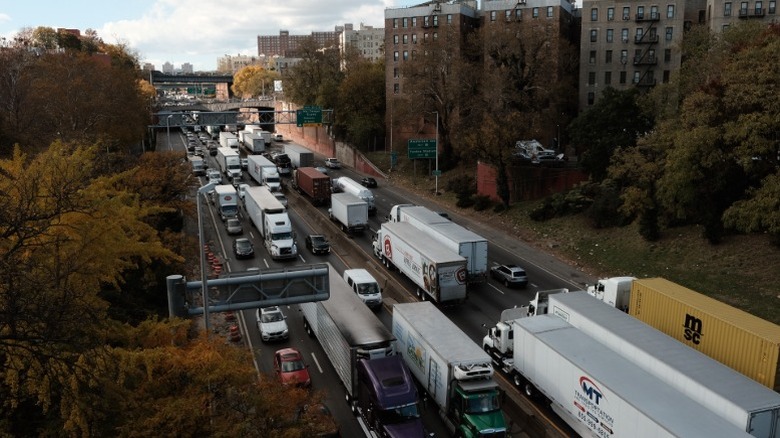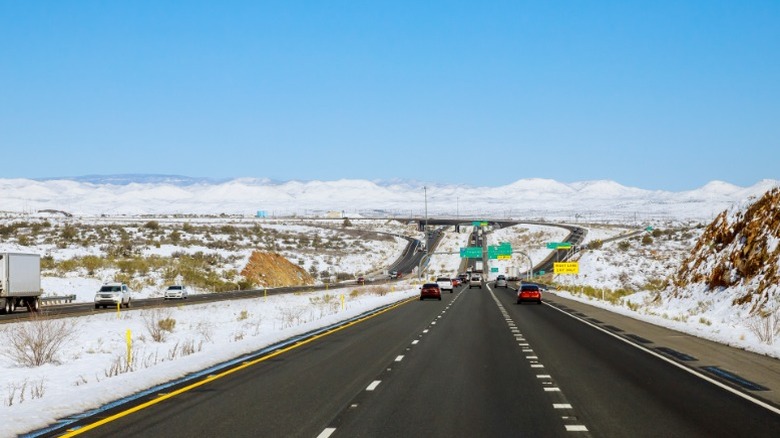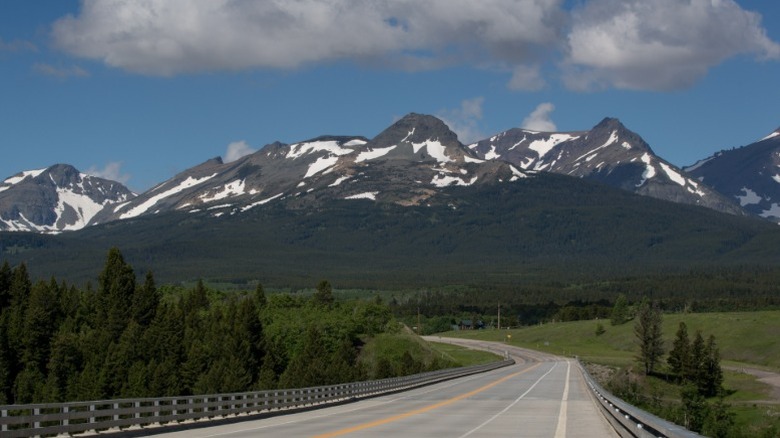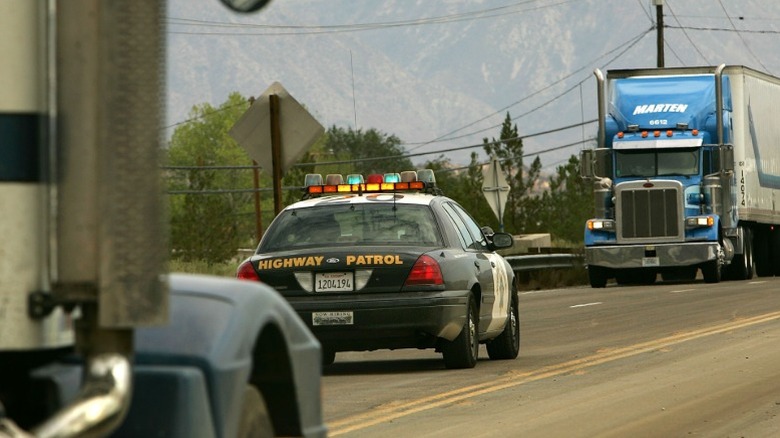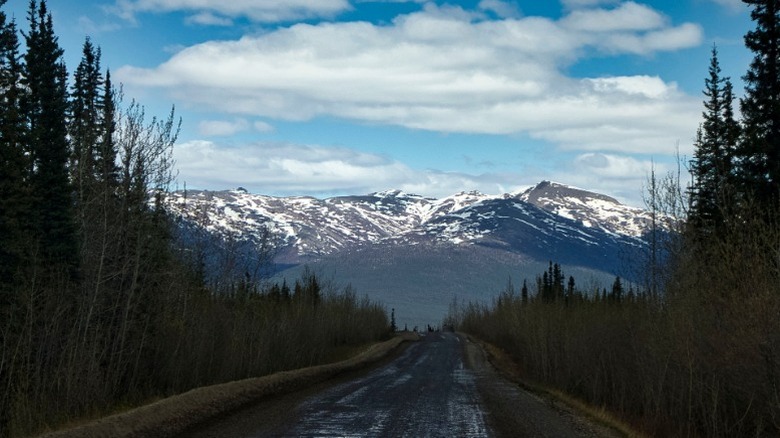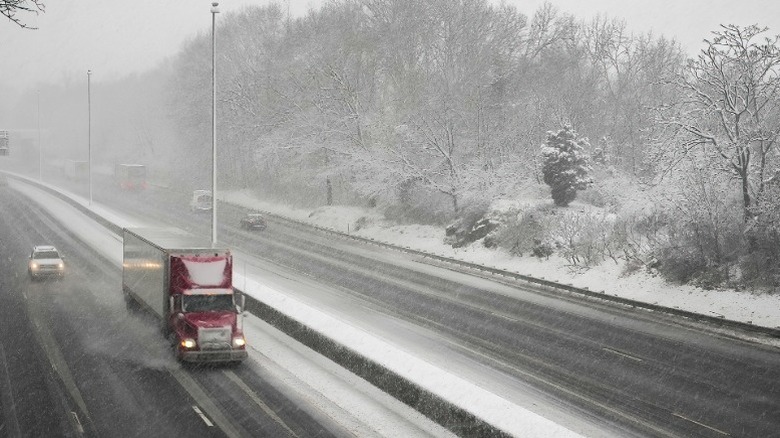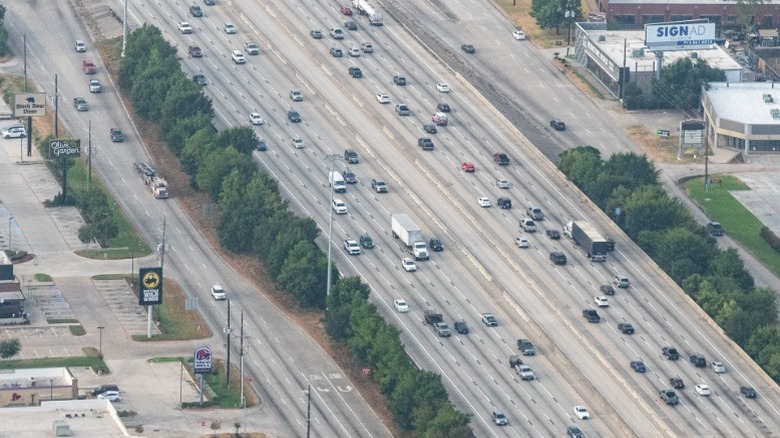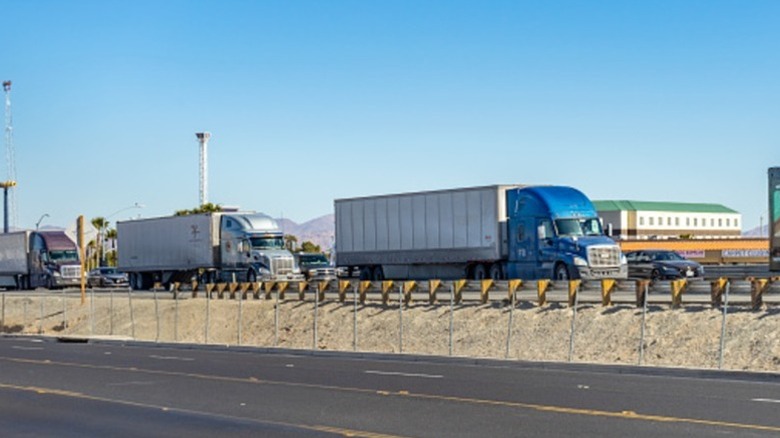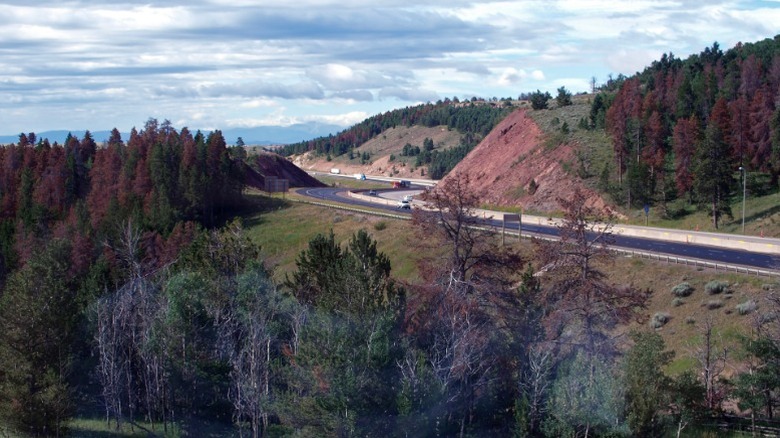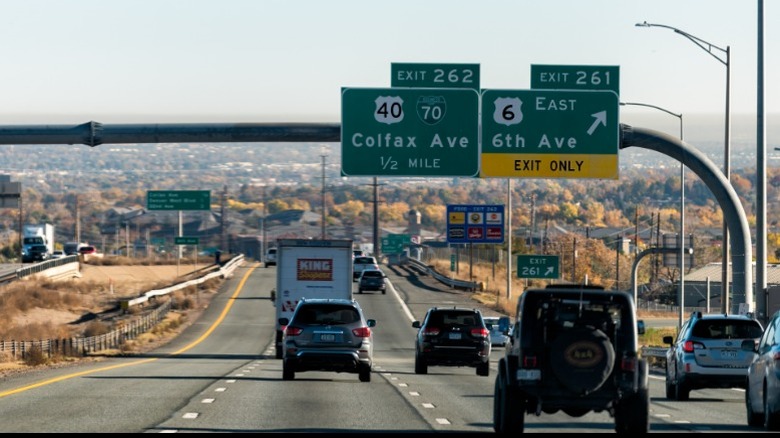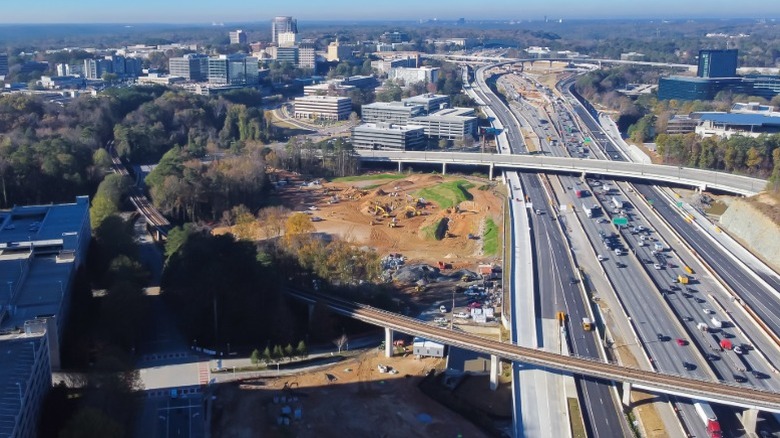13 Of The Most Dangerous Roads For Semi-Truck Drivers
While semi-trucks only make up about 5% of registered vehicles in the U.S., there are millions of them in the country. And with these vehicles averaging 45,000 miles every year, you'll find them all over your interstate highways and rural roads transporting goods, equipment, and chemicals over long distances.
Because of the safety concerns with semi-trucks due to their size, they aren't allowed to drive just anywhere and at any time. There are laws that constrain the hours of driving and restrict trucks to specific roads or routes. However, despite these measures, semi-trucks are involved in a substantial number of fatal accidents every year. In 2023 alone, 4,354 people reportedly died in large truck accidents, according to the Insurance Institute for Highway Safety (IIHS).
The truth is, there is no single cause behind these accidents. Multiple factors come into play, but dangerous roads are a major piece of the puzzle. From heavy congestion to terrible weather conditions, poor maintenance, and complex routes, some locations have become notorious for major accidents, giving drivers a headache when navigating them. We combed through accident data to determine 13 of the most dangerous roads for semi-truck drivers.
The Cross-Bronx Expressway
Apart from its vibrant art and culture scene, the Bronx is known for its high population and insane traffic. One of its major freeways and a critical aspect of its road network, as well as that of New York as a whole, is the Cross-Bronx Expressway. This road spans 6.83 miles and features multiple interchanges and exits, cutting through various communities in the Bronx.
Road accidents every year on this road are in the hundreds. In 2021, the Macoombs road overpass was reported as the most unsafe zone, with 13 accidents and 24 injured motorists. Contributing factors for accidents on this expressway include its location in a densely packed urban area, along with poor foresight in planning. Thus, the Cross-Bronx Expressway is notorious for severe congestion. Every day, over 184,000 vehicles use this road, and out of this number, 15,000 are large freight trucks. Lane change hazards also seem to be a significant factor, especially considering the complex traffic dynamics, narrow lanes, tight curves, and limited visibility.
The Million Dollar Highway
Formerly known as Highway 550, the Million Dollar Highway is known for many things: its surrounding mountains, scenic views, and, unfortunately, dangerous driving conditions. It has consistently been recognized as one of the most dangerous roads for American truck drivers.
The problem with this road is largely its surrounding terrain and construction layout. Its elevation reaches as high as 11,018 feet, and there are no guardrails, so vehicles are driving along the edge of steep cliffs. On top of that, the lanes are narrow, making it difficult for cars to drive side by side or overtake each other, and you'll find many sharp, blind curves that drivers have to navigate very carefully. Even small errors on this road can result in fatal accidents. This is why it is such a scary road for trucks. The wide body of your vehicle would have you feeling like you're falling off the edge.
On average, the Million Dollar Highway records forty accidents and seven deaths every year. Most accidents on this road involve vehicles veering off the road or front and rear-end collisions. A dump-truck and a semi-truck were once involved in a tragic fiery collision here that led to the death of the semi-truck driver. Avalanches also pose a significant risk factor. A few months ago, a truck got hit by an avalanche, and only a few hours after efforts were made to clear the debris, another one struck. So, even though many travel on this road without issue, as a truck driver, it's not recommended to take this route if you're not the best with mountain roads.
I-17 Arizona
Arizona has not earned a great reputation for its roads over the years. In 2018, its interstate highways had higher rates of fatalities than any other state in the U.S., and data from national transportation research organization TRIP revealed that a year later, the highway deaths per 100 million vehicle miles in Arizona were significantly more than the national average.
Interstate 17, in particular, is one of the roads that has received negative attention in this state. It once earned a top-four spot among the deadliest highways in the United States, and a look at its conditions shows that this rating is well-deserved. Lying between Phoenix and Flagstaff, this highway winds through beautiful terrain, but it also features a lot of fluctuations that can make it pretty hazardous to navigate. Over a 5-year period between 2011 and 2015, Interstate 17 had 123 fatal accidents.
As a truck driver, you'll need to be extra vigilant of the road conditions and driving behavior. In 2022, two semi-trucks collided on this road and were engulfed in flames, temporarily shutting down the road. Pay attention to weather conditions like snow, rain, and fog, as these conditions can make driving trickier than you think. You should also watch out for the portion of the road within the Phoenix city limits, as this area is particularly prone to accidents.
U.S. Highway 2 in Montana
Running along the north of Montana, near the Canadian border, U.S. Highway 2 is another danger zone for semi-truck drivers. It records more fatal accidents than any other road in the state. This remote highway stretches 666 miles and is a long and desolate journey to undertake. Some dub it the Lonely Road, and it's because of how secluded it can feel. Imagine driving along a long, isolated road with no proximity to emergency assistance. That's precisely what navigating this road is like.
So, you'll have to worry about the high rate of accidents that occur here, as well as how long it takes for emergency responders to arrive. Victims of car accidents may spend up to 80 minutes waiting for an ambulance to arrive. In addition, Highway 2 has narrow lanes and limited lighting, which are definitely of no help to a driver unfamiliar with its route, especially since the speed limit is 70 mph.
California Route 138
California Route 138 has earned the nickname "Highway of Death" and "The Blood Alley." It's a treacherous road that accounts for a high number of accidents, especially for its size. It spans 105 miles, passing through the Mojave Desert, and then reaches Palmdale, where it overlaps State Route 14, and then goes eastward towards Crestline.
Considered one of the deadliest routes in California, Route 138 at some point averaged 10 fatal accidents every year, with driver behavior being a cause. Following a recent accident involving a semi-truck, the California Highway Patrol reported that many truckers disregarded road signs, instead relying on GPS. But a lot of problems also have to do with the road. Known for its narrow two-lane highway, lack of divider between lanes, numerous curves, and regular heavy traffic, the road has become associated with disaster.
Although a project has been undertaken to widen the road to four lanes in certain sections, you still have to be wary of the twists and curves on this highway, especially when driving a vehicle as large as a semi-truck. Drivers who use the route advise against driving at dusk or dawn, and to avoid driving at night entirely.
Dalton Highway in Alaska
The Dalton Highway has become so associated with its solitude that some might consider it the loneliest road in the world. Located in the far north, it was originally built to service oil fields and facilitate the development of the Trans-Alaska pipeline. Today, it still consists mainly of commercial vehicles that provide supplies to the North Slope oil fields. In fact, much of the traffic is caused by commercial trucks.
The natural landscape of this highway means drivers get to witness beautiful and captivating sights, but on the other hand, they may also encounter wild animals such as wolves, squirrels, and bears that dwell within its surrounding forests and mountains. In addition, due to the weather and terrain, driving conditions can be difficult and unpredictable. The road is narrow with sharp rocks and gravel, steep grades, and often accompanied by bad weather that impairs visibility. Sometimes the heavy snow prevents semi-trucks from moving at all. It's not uncommon to find freight trucks with tire chains to support traction.
This 414-mile stretch has no medical facilities, banks, grocery stores, or vehicle repair services, and on top of that, the internet service is poor. This means driving on this road requires sufficient preparation. Drivers would be wise to have extra food, water, supplies, and emergency gear on hand before tackling this remote stretch of roadway.
I-95 in Connecticut
Some roads are nearly impossible for commercial vehicles to avoid, despite how dangerous they may be. Interstate 95 is one of these. It is a major route for truck drivers, and one that has earned a reputation as Connecticut's most dangerous highway. Yet, it averages 100,000 vehicles every day.
The main reason this road is so dangerous is the weather conditions in the area. During the spring, rainfall is heavy, and in the summer, high winds and even windstorms occur. In addition, there is often immense traffic congestion on this road, especially in southwest Connecticut. As a result, accidents here often result in fatal injuries.
According to a study by the National Highway Traffic Safety Administration and the Federal Highway Administration, over the course of a decade, the road has had 147 fatal crashes, averaging 15 per year. Drivers and motorists hate this road so much that it was ranked 11th in a survey of the top 100 most hated roads in the U.S.
Interstate 45, Texas
As one of the largest states in the country, Texas has a pretty busy transportation system. Interstate 45 serves as a link between two of its major cities, Dallas and Houston. This road sees thousands of commuters, travelers, and commercial transporters every day, especially in its urban areas, leading to congestion and high traffic in many sections.
However, Interstate 45 also cuts across rural areas, and this means the traffic conditions can fluctuate. These changes in traffic patterns can catch drivers off guard, and it doesn't help that the road stretches hundreds of miles either. It's common for vehicle owners to stay on the road for several hours, leading some to become impatient, drive at high speeds, or engage in reckless behavior.
Apart from the traffic situation, this road is vulnerable to severe weather conditions, particularly hurricanes, which areas in Houston are prone to. In fact, it often experiences flooding and has been closed down on some occasions due to high water levels. Drivers have to navigate very carefully in order to drive safely in such conditions.
I-15 in California
California is no stranger to truck accidents. In 2022, truck accidents in California alone accounted for 7% of all truck accidents in the country. Only 3 years prior in 2019, it recorded 408 fatal crashes involving large trucks, the second-highest in the country. So, it's no surprise it's home to some dangerous roads, one of which is Interstate 15.
This road actually passes through six states: California, Nevada, Arizona, Utah, Idaho, and Montana, beginning in San Diego and ending north at the Canadian border. However, the portion of the highway that has gotten the most safety concerns is in San Bernardino County. According to Consumer Affairs in 2022, this is the deadliest county in the state, with 20 casualties per 100,000 people. Interstate 15 was the biggest contributor with 48 fatalities that year, about 31% higher than the rate in 2018.
The reason for this problem is the increase in population in many affected areas. This spike seems to have boosted traffic congestion in a way that road safety measures have not been able to keep up with. There also seems to be a speeding problem with drivers, given that 22 of the fatalities in 2022 involved speeding.
I-10 Louisiana
Known as Interstate 10, this prominent highway begins in Santa Monica and extends to Jacksonville, Florida, covering nearly 2,500 miles. It's a major route for commercial trucks, and the fourth-longest interstate highway in the U.S. A study between 2015 and 2017 by Safer America Consumer Safety Information found that Interstate 10 had the highest number of fatal crashes in Louisiana, with 136 fatalities.
Interstate 10 is especially dangerous due to a particular stretch, known as the Devil's Triangle, located west of Baton Rouge between Grosse Tete and the LA exit at Port Allen. Here, three lanes converge into one, a nightmare for any trucker, and this abrupt change causes bumper-to-bumper traffic that increases the risk of accidents. This area experiences more than 800 crashes each year. Another danger zone is the stretch through New Orleans, which also records a high number of fatal accidents.
One of the main reasons for accidents on Interstate 10 is the poor lighting conditions. This road is notoriously dark, and a significant number of its fatal accidents occur at night. Distracted and drunk driving is another major problem. Even the National Highway Administration has recognized this road as one of the deadliest for holiday travel.
I-80 in Wyoming
Wyoming is loved for many things, but its highways are not one of them. When it comes to driver safety, it has a pretty negative reputation. If you've ever had to drive on Interstate 80, you probably have a good idea why this road is so problematic. From high winds to snowstorms, the weather in this area can be very dangerous for any driver, especially in inclement winter weather. It has even been tagged the Snow Chi Mihn Trail. As a result of this persistent problem, the road is closed off frequently.
The nature of emergency response along this road doesn't help either. It can be painfully slow, and drivers usually have to prepare for the possibility of getting stranded. So if you're driving this route, you'll want to have essentials like first aid, blankets, flashlights, and snow boots. Interstate 80 is also a very busy road that sees a lot of traffic. Up to 24,000 vehicles may use this road in one day. All of these contribute to high accident levels, especially for commercial vehicles. In fact, within a 5-year period, there were as many as 8,100 crashes on this highway, and more than half of these involved commercial vehicles.
I-70 Colorado
Driving through Interstate 70 in Colorado is a journey you have to prepare for. Although many trucks navigate this road regularly, it can be quite unpredictable. Because this road is a crucial artery connecting communities and facilitating commerce, many vehicles and large trucks use it on a daily basis.
However, there are several problems with this route, one of which is the weather and terrain. The road traverses a mountainous landscape and encounters severe weather conditions, including icy roads and snowstorms. Drivers might find themselves stuck or having to detour due to an avalanche or boulder crash, and if they're not prepared ahead of time, this can be a major inconvenience — or worse.
Additionally, there are frequent sharp turns and steep descents on this road that an inexperienced driver would really struggle with. When driving a large vehicle like a semi-truck, you have to be extra careful and vigilant. Data from the Federal Motor Carrier Safety Administration (FMCSA) indicate that crashes involving large trucks on this road are disproportionately higher compared to those involving passenger vehicles. Recent data from the Colorado Department of Transportation (CDOT) showed that Interstate 70 had more than 200 crashes involving large trucks in a single year.
Georgia I-285
Interstate 285 is a very busy road, as it serves as a major route in the city, connecting other interstate roads. On top of that, there's a poor public transportation network, so large trucks and vehicles are constantly on the road. Every day, there's an influx of motorists commuting and navigating the city, and it has among the highest truck volumes in the state.
Since 2001, over 200 trucks have rolled over on Interstate 285. According to the University of Michigan, 58% of fatal truck driver injuries involve rollover accidents, despite rollovers constituting less than 5% of truck accidents. In addition to that, Interstate 285 is the site of an average of 3.5 fatal accidents every 10 miles. It makes sense that it is considered the most dangerous road in Atlanta.
The design of this road itself is a problem. The signage is poor, and the lighting is terrible, and with various tight bends and difficult curves, drivers are bound to make mistakes. There are barely any entrance and exit ramps. These issues are unsurprising when you consider the fact that the road wasn't originally designed to accommodate large trucks or a high number of vehicles, so it doesn't seem well-suited for the traffic it handles. But that aside, there's also a speeding problem that contributes to frequent accidents. In 2024, there were 1,192 accidents reported on this road.

